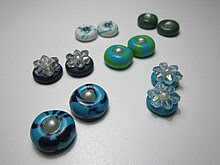What kind of paint is best on pottery/clay, by Ronnee Strickland
What kind of paint can you use on pottery?

What kind of paint can you use on pottery? What color will your paint be and where will you apply it? These are all very important questions to consider before you start painting pottery.
When you first start learning how to paint on pottery, the best thing to do is take a class. Or read a great book on the subject and practice. But a class will probably save you money. And if you plan to bake your pice of art after painting, be certain the paint will withstand the heat. It is usually written on the bottle in which you purchase the paint. If you purchase it from Amazon, this is usually included in the “details.” You can often find inexpensive classes at your local community center or even go for an evening at Pottery U Paint. What you want to do is bring enough paint with you so you won’t have to come back later to change colors. This way you don’t have to worry about running out of paint or making the drive back and forth from the store. Their paints will probably more expensive which is sometimes compensated by the convenience or the fact an expert there can steer you in the right direction, thereby possibly costing you less money in the long run.
When you are learning how to paint on pottery, you want to avoid the use of acrylics. Acrylics are a type of paint that is specially formulated to resist staining. However, they are also very thick and you have to let them dry between layers. In addition, some people have a hard time removing acrylics because they feel they are rubbing the glaze off of their pottery. So, if you are concerned about this, then you might want to stick to using oil paints or water-based acrylic paints instead. (Not true with polymer clays. acrylics work well with this “clay.”
Another good thing to keep in mind is to select a paint that doesn’t bleed. If the paint dries on your piece of pottery, you run the risk of the paint staining your surrounding surfaces. So, you want to make sure you use a high quality acrylic paint that dries well. The only way to tell if a particular paint will bleed is to rub a part of the piece with your fingers. If the paint comes out clean, then the paint isn’t likely to bleed and you can use it on other pieces.
You also want to avoid paints that are designed to be porous. These types of paints can sometimes have an adverse affect on certain pottery items. Also, you want to avoid any paint that has been diluted with water. This means that the paint won’t stand up to the type of work you do and it could chip off over time. However on polymer clay, test this, but lots of time heat will help adhere the paint. You will also probably be varnishing your piece after painting. (After varnishing, remember, you cannot put the piece in the oven.
Knowing how to paint on pottery is a fun skill that you can perfect over time. It takes a little bit of patience to learn how to use this type of paint properly. However, it can also be fun and interesting once you get the hang of it. Just think about all of the beautiful colors you can create once you get good at this!


Comments
Post a Comment